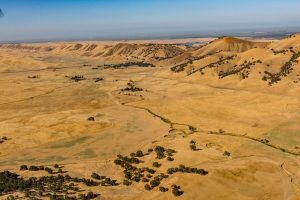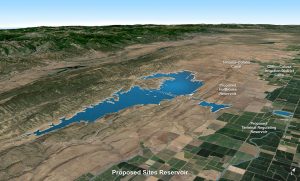
By Jeff Sutton, General Manager, Tehama-Colusa Canal Authority
Vice Chair, Sites Project Authority
In California, we have experience with droughts. Drought is an inevitable and predictable reality for our state. In 2021, after back-to-back critically dry winters, California’s farms and our rural communities are facing a real and imminent threat as we approach the hottest, driest months of the summer irrigation season. While we brace for the impacts of this challenging water situation, our farms and local communities are simultaneously dealing with the huge economic impacts and uncertainty created by the COVID-19 pandemic that has hit California’s rural communities hard.
Northern California reservoirs, the foundation of both the Central Valley Project and the State Water Project, are at historically low levels and continue to fall. The Sierra Nevada snowpack, that serves as our mountain reservoirs, is well below historic averages.
As the General Manager of the Tehama-Colusa Canal Authority, I know first-hand how impactful drought can be to California farms and ranches and how devastating it can be to the rural communities that rely on an agricultural economy that provides the food and fiber for our nation and the world. The Tehama-Colusa Canal Authority is comprised of 17 water contractors spanning four counties (Tehama, Glenn, Colusa, and Yolo) along the west side of the Sacramento Valley, with a service area of 150,000 acres, producing over $250 million in crops per year, and contributing over $1 billion to our regional economy annually.
The circumstance we find ourselves in today is a prime example of why we need to build Sites Reservoir now. Just a couple of years ago, in 2017 and 2019, we experienced a series of atmospheric river events that produced so much runoff that it overtopped our flood control system causing localized and regional flooding impacts throughout Northern California. If Sites Reservoir had been in place during that time, not only could we have avoided many of those flooding impacts, but we also could have captured and stored much of this excess runoff for use in a dry year like we are currently experiencing. In fact, if Sites Reservoir were constructed and operational over these past few years, we would have a million acre-feet of water stored for use today to help mitigate the impacts we are currently experiencing during this very difficult drought situation.
Sites Reservoir is a proposed multi-benefit, off-stream water storage facility, located north of Sacramento in rural Colusa and Glenn counties. Sites will serve to capture and store stormwater and flood flows in the Sacramento River, after all other water rights and regulatory requirements are met, for release primarily in drier years, such as 2021. This is not a big on-stream dam project of past generations.

Sites is a modern, 21st century water storage facility. It utilizes existing state-of-the-art screened, fish friendly water diversions on the Sacramento River and existing water conveyance facilities (GCID, TCCA, and the Colusa Basin Drain). It provides a new off-stream water storage facility that integrates perfectly into our current water management system. In fact, not only does this project have an extremely benign environmental impact, it also dedicates a significant portion of its water supply and operational benefits to the enhancement of terrestrial and aquatic environments.
In California, we have relied on the Sierra Nevada snowpack and the spring/summer runoff to fill our reservoirs and recharge our groundwater aquifers – which in turn provides water for agricultural, environmental, and urban uses.
However, this snowpack has become less reliable due to the effects of climate change. Much of California’s precipitation now comes from intense storm events that produce extreme amounts of stormwater that runs off before it can be captured for maximum benefit. Sites Reservoir is specifically designed to store the water generated by these storm events for use during times of drought when the water is so desperately needed.
California’s water management infrastructure was predominantly developed in the 20th century and was not designed to operate under anticipated future climate conditions. Further, our aging and insufficient water infrastructure was developed prior to the population boom California has experienced over the last half century and is now being stressed beyond its capabilities. Our needs for water to serve our communities, our farms, sustain our environment and to fuel our economy has increased far beyond the capacity of our current water supply system. This has resulted in a predictably unreliable and unsustainable water management system during periods of drought.
Simply put, our current water infrastructure was not designed with future climate conditions in mind. But Sites Reservoir is! Extensive modeling has indicated that Sites Reservoir actually performs better, and provides even greater water supply benefits to farms, people, and the environment of California, under even the most challenging climate change scenarios.
Sites Reservoir is a generational opportunity to construct a multi-benefit water storage project that helps restore flexibility, reliability, and resiliency to California’s water supply. Designed to integrate, augment and improve our existing water infrastructure, no other storage project currently contemplated can positively affect our statewide water system like Sites Reservoir.
And the benefits go well beyond agriculture. Sites Reservoir will likewise have a significant, positive impact on the environment, which also suffers during drought conditions. A significant portion of the Sites Reservoir Project’s annual water supplies will be dedicated to environmental uses to help improve conditions for Delta smelt and to improve Pacific Flyway habitat for migratory birds and other native species. In addition, in years like 2021, Sites could greatly help operations to preserve the cold-water pool in Shasta Lake into the late summer months to support salmon development, spawning, and rearing.
While located in the Sacramento Valley, the significant benefits associated with Sites Reservoir will accrue statewide. Cities and water agencies from across California, as well as our federal and state partners, are collaborating to make Sites Reservoir, and these resulting benefits a reality. As stated before, drought conditions in California are inevitable and predictable. However, with prudent investments in necessary water infrastructure, the impacts from the intermittent droughts that California experiences can be greatly mitigated and more effectively managed. By building Sites Reservoir, we have a unique opportunity to greatly change the way droughts impact farmers, people, and the environment. It’s time to build Sites now.




